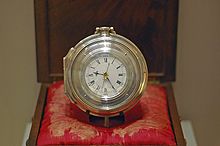Length clock

As a longitudinal clock , marine chronometers , marine chronometers or ship's clock that are chronometer indicated that to determine the longitude used. The introduction of this instrument made it possible for the first time to determine the longitude on the high seas with sufficient accuracy.
functionality
The rotation of the earth leads to an apparent movement of the heavenly bodies (sun, stars, moon) in the firmament . Since the earth rotates by a known amount in a certain time, the time difference between such events at the respective observation locations is in a fixed ratio to the difference in length of their positions.
The exact point in time of such events (such as the sun's passage through the meridian at noon ) is therefore dependent on the observer's location on the globe - exclusively on its longitude, i.e. its offset in an east-west direction. With the help of a chronometer, the time difference between such an event at the observation location and the time at the location for which both the longitude and the time of this event are precisely known is determined. To do this, the chronometer must be synchronized with the time of the known location.
The difference in length can then be calculated from the observed time difference:
Since the sunny day , defined as a complete apparent revolution of the sun in the sky (360 degrees), lasts on average 24 hours or 1440 minutes, there is a time difference of exactly four minutes per degree Difference in length. A ship whose local time is exactly 48 minutes behind that of a defined prime meridian (for example that of Greenwich ) would therefore be twelve degrees west of this prime meridian. A rate deviation of the clock causes inaccuracies in the determination of the time at the prime meridian and thus the longitude - it is not possible to determine which part of the time difference is due to the geographical position reached and which is due to the deviation of the clock achieved up to that point. Since sea voyages could sometimes take several weeks or months, navigation using this method was therefore only possible when sufficiently accurate clocks could be produced.
history
For centuries the problem of determining length on the high seas preoccupied all nations with ocean-going ships. In England in 1714, for example, prize money was offered to solve the length problem , but all earlier concepts failed due to their inadequate practicality.
A vehement fighter for the concept of the length clock on sea voyages and the builder of the first clocks with sufficient accuracy was John Harrison . He presented the first watch as early as 1735, but was not able to establish his concept on a broader basis until 1759 with his fourth model.
The end-to-end equipping of ships with length clocks began in England in the late 18th century and was not fully completed until 1840. From 1829 onwards, time balls were installed in many ports to make checking clocks easier, most of them were torn down again in the 1920s, and time signal transmitters had been around since 1907 .
Today, position determination on ships is mainly carried out using satellite navigation . Mechanical ship's clocks are usually no longer in use, but now serve purely decorative purposes. In the study of nautical but is celestial navigation , including the determination of the length by means of time measurement and sun observation, further taught.
literature
- Dava Sobel and William JH Andrewes: Longitude - The Illustrated Edition . The true story of a lonely genius who solved the greatest scientific problem of his time. Berlin-Verlag, Berlin 2010, ISBN 3-8270-0970-7 (English: Longitude . Translated by Matthias Fienbork and Dirk Melder).
